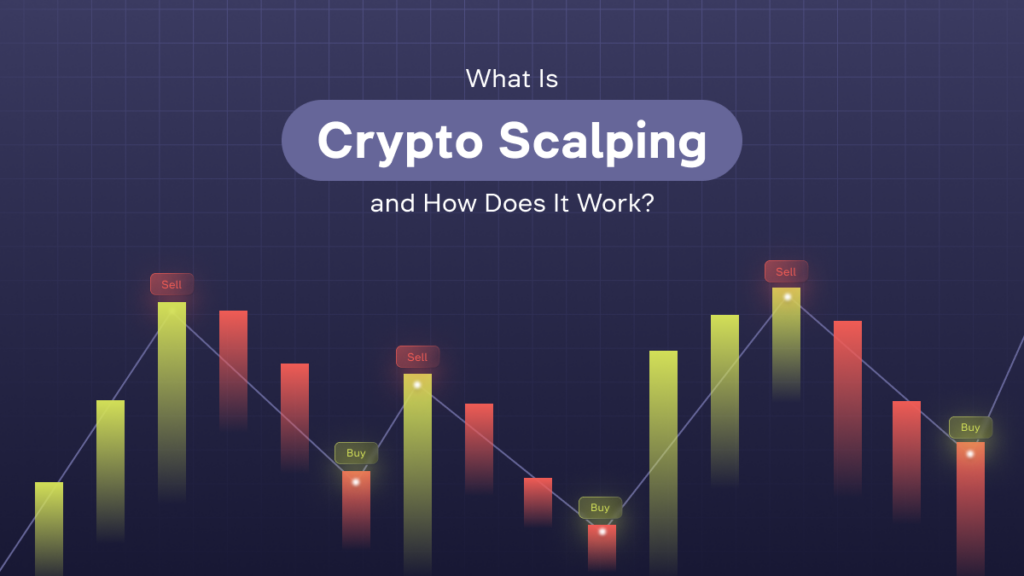What Is Crypto Scalping, and How Does It Work?

Content
Key points:
Cryptocurrency scalping is a trading strategy in which a trader executes many quick trades in order to capitalize on small fluctuations in asset prices and accumulate these profits.
Scalping is a high-risk strategy that requires constant monitoring of the market and news, along with the use of analysis tools, technical indicators, and trading strategies such as range trading, spreads, etc.
Scalping gives results quickly but requires very frequent trades and can be exhausting.
This strategy is more suitable for experienced traders who know how to manage emotions and risks and have a clear trading strategy that they follow.
In the cryptocurrency market, asset prices change every second, and traders seek to capitalize on micro-movements of prices within the shortest time frames. In such conditions, they often use a scalping strategy.
In the article, we talk in detail about how to scalp crypto, as well as about elements, mechanics, strategies, indicators, and factors that determine the effectiveness of this strategy in the digital assets market.
Crypto trading scalping is a trading strategy that consists of making many quick trades aimed at profiting from small price changes. Traders seek to make money even on the smallest price movements when the market hardly experiences significant price fluctuations, for example, buying an asset at a price of $100 and selling it at $101.
How Does Scalping Crypto Work?
Scalping in crypto involves making small profits from trades that accumulate into significant revenues. To take advantage of market volatility, traders monitor price movements and execute multiple trades, typically lasting from seconds to minutes. The strategy goal is to accumulate small profits that will generally outweigh the cost of trading fees.
Scalping vs. Day Trading vs. Swing Trading
These 3 strategies are often compared because they focus on short-term trading. Despite the fact that they differ in terms of time frames, frequency of transactions, and other factors, they are all used with the goal of making money precisely on short- and medium-term market movements. A comparison of these strategies is shown in the table below.
| Key Parameters | Scalping | Day Trading | Swing Trading |
| Time Frame | Ultra-short-term trades, which last second or minutes | Trades are executed within a day and can last from minutes to hours | Trades are held for days to weeks |
|
Profits from |
Focuses on small price movements | Capitalizes on daily price fluctuations | Aims to benefit from medium-term market trends |
| Trading Frequency | High trading frequency | Moderate trading frequency | Lower trading frequency |
Types of Crypto Scalping Strategies
Trading strategies provide a clear framework for making decisions in the market. They help reduce the emotional impact of trading, provide a concrete plan of action to achieve your goals, and include risk management tools to reduce losses in the event of unpredictable market movements. Let’s consider several popular strategies traders apply to scalp trade crypto.
Range trading
It involves trading in certain price ranges where the value of the asset fluctuates. Predictive price patterns, trend, and counter-trend trading are used for this.
The crypto scalper community scrutinizes historical price data, looking for recurring patterns and trends that indicate the upper and lower limits of a price range. Additionally, indicators such as the Relative Strength Index (RSI) and Moving Averages (MA) allow you to gauge market sentiment and identify potential entry and exit points within a set range.
Bid-Ask Spread
This strategy capitalizes on the price spread between the highest bid (the maximum price a buyer is willing to pay) and the lowest ask (the minimum price a seller is willing to accept). Traders employ this approach by meticulously tracking buy and sell order prices to gauge market depth and identify potential price pivot points. They rely on technical analysis techniques, such as studying candlestick charts and analyzing trading volume, which indicates the quantity of assets traded within a specific market timeframe.
Arbitrage
Crypto arbitrage involves the use of price differences for the same asset on different exchanges. Traders buy an asset at a lower price on one exchange and sell it at a higher price on another. To do this, they use arbitrage software (CoinArbitrageBot, Bitsgap, CryptoTriangular, HaasOnline, Zignaly) to automatically detect these variations and provide real-time price notification functionality when significant price gaps occur. In addition, cryptocurrency price trackers (CoinMarketCap, CoinGecko) facilitate comparisons across multiple exchanges, helping to identify potential arbitrage opportunities.
Price Action
This analysis involves studying price fluctuations within the specified timeframe to forecast future price dynamics. Identifying trends, support and resistance levels, and potential price reversal points is achieved through the examination of candlestick charts and historical patterns, aiding in making predictions regarding the future price movement of the asset.
Margin Trading
To scale the strategies mentioned above, traders use borrowed funds while scalp trade crypto. In margin trading, the trader uses a loan from the exchange or broker (i.e., leverage) to increase the value of their positions and, thus, potentially increase their profits.
Scalping Indicators Overview
A technical indicator is a visual representation of mathematical calculations based on price data, trading volume, and other indicators of cryptocurrencies. They are used to analyze the market, find trends, and maximize the effectiveness of scalping trading cryptocurrency strategies.
Indicators are needed to make informed trading decisions and are often part of the technical analysis of crypto assets. The following indicators are most often used in scalping:
Moving Average (MA)
The moving average indicator shows the average value of the price over a certain period of time. It helps identify trends and their direction by smoothing out the fluctuations in price movements.
Relative Strength Index (RSI)
RSI analyzes the intensity of price impulses and indicates whether the asset is overbought or oversold. By analyzing the RSI, you can identify potential reversal points and learn about the strength of the current market trend.
Support and Resistance Levels
Support levels represent a price point with a significant concentration of buy orders, typically acting as a springboard for price movement upward. These levels often signal a potential halt to a bearish (downward) trend. Conversely, resistance levels denote price levels with numerous sell orders, often serving as a barrier where bullish (upward) momentum might stall.
Stochastic Oscillator
This indicator compares an asset’s closing price within a specific timeframe to its price over a defined period, aiding in the detection of potential trend reversals and offering insights into market dynamics.
SAR (Stop and Reversal)
SAR is based on the concept of trend analysis, aimed at identifying potential changes in the direction of the market trend. It helps to recognize potential moments when the current trend can stop and go in the other direction.
Scalping Crypto Tools
Besides using indicators, cryptocurrency scalping traders utilize a range of tools to enhance their trading performance. These instruments offer crucial real-time insights into the crypto market, streamline decision-making, fine-tune trading strategies, execution, and much more.
Bots
Trading bots automate trading through algorithms and market signals, allowing them to trade on your behalf and seek out profitable opportunities, all without the need for constant monitoring on your part. A bot can be a valuable assistant, especially for users who are keen on learning how to do crypto scalping but lack knowledge or time.
Crypto API tools
APIs (Application Programming Interfaces) provide seamless access to real-time market data, trading functionality for scalping in crypto trading, and various analytical tools offered by other sources. For instance, with our API, you can trade on our crypto exchange from another website.
Crypto Trading Charts
The crypto chart illustrates the asset price dynamics over the selected period, market sentiment, opening and closing prices within defined intervals, and more. Trading charts are fundamental tools extensively analyzed by traders during trading activities. Some also offer the option to display technical indicators, such as TradingView.
On our exchange, you can enjoy all the benefits of the TradingView chart by selecting them on the trading page, located at the top right of the chart. It allows you to customize the chart space of your chosen pair to your liking, add notes, and apply necessary indicators for convenient analysis of current and historical market data.
Pros Of Scalping Crypto
- Potential for quick profits through short-term crypto scalp trading and capitalizing on minor price differences.
- Scalpers operate within the realm of subtle market fluctuations, which may go unnoticed by traders employing different strategies.
- By leveraging even minor price divergences and executing a high volume of trades within a short timeframe, scalpers enhance their overall income.
Cons Of Cryptocurrency Scalping
- The higher asset volatility significantly impacts scalping in cryptocurrency, as traders operate within the domain of small, rapid fluctuations, which escalates the risk of sudden and substantial price swings, leading to potential financial losses.
- Scalping requires keeping a constant watch on market trends and making quick decisions, which demands a significant amount of time and makes trading exhausting.
- Frequent trading may also result in elevated fee costs, potentially affecting overall profitability and even surpassing earnings.
Crypto Scalping Tips
Before starting cryptocurrency scalping, it is important to have a clear trading plan. If you don’t have a trading strategy yet, read what it includes here. And here are some practical tips that will contribute to more effective work with the scalping strategy:
Manage or learn to manage risks. Set clear limits on the amount you are willing to risk and desired price levels for trading. This allows you to safeguard your investments during volatile market conditions. By the way, you can also set Stop-Loss and Take-Profit levels to sell an asset automatically when its price reaches the desired profit or loss threshold.
Calculate and then calculate again. Scalping may incur losses due to commissions, so don’t hesitate to use a calculator while learning how to scalp trade crypto to estimate potential earnings alongside fee costs.
Give preference to highly liquid assets. Such assets are less prone to sharp price fluctuations. Moreover, such cryptocurrencies can be quickly bought and sold since their order books are not plagued by trading order congestion.
Stay informed. Regularly monitor market news and keep an eye on industry developments and regulatory changes. This can help anticipate market sentiments and adjust your trading strategy accordingly.
Don’t overlook analysis tools. Candlestick charts, trend indicators, and other analytical instruments can provide valuable market insights and aid in making well-informed trading decisions. For instance, indicators like MACD (Moving Average Convergence Divergence) or Bollinger Bands offer data to interpret market trends and volatility.
Practice discipline and patience. Discipline is crucial in trading, so avoid impulsive decisions driven by market fluctuations and wait for the right opportunities. Instead of tracking every minor market move, focus on trades aligned with your predefined strategy and risk management plan. If emotions still hinder your trading, you can consider using scalping bots. However, choose your assistant carefully and keep in mind that they don’t guarantee profits; they just apply trading algorithms that may yield income over the long term.
Conclusion
Scalping is a high-frequency trading strategy involving a large number of rapid trades targeted at profiting from even the smallest price fluctuations. Despite the associated risks, the potential for quick earnings makes cryptocurrency scalping a popular choice among traders. Scalpers rely on various trading methods, indicators, and other crypto tools to make informed decisions. Successful scalping requires a deep understanding of market dynamics, data-driven trading rather than emotion-based, and the ability to make swift and well-founded decisions, which is why it is typically employed by experienced traders.
FAQ
This strategy is suitable for experienced traders who have a deep understanding of the volatile crypto market conditions. It requires a profound comprehension of market dynamics, quick decision-making skills, and the ability to effectively manage high levels of risk.
Scalping can be profitable, but it demands a profound understanding of market trends and the ability to steer through sudden market swings effectively.
Scalping stands out from other trading strategies in terms of timeframes and trading frequency. It intends to make small profits from minor price movements within very short timeframes, often in seconds or minutes, while other strategies may involve holding positions for more extended periods to capture more significant price movements.
This strategy is usually applied to trading intervals ranging from seconds to minutes. Traders closely monitor market fluctuations and execute multiple trades within these short timeframes.
Scalping is generally not recommended for beginners. Those lacking sufficient experience and skills are better off starting with less complex trading strategies that require a lower level of active market monitoring and decision-making. For instance, swing trading, which focuses on medium-term trends or long-term cryptocurrency holdings, often referred to as HODLing, could be more suitable.











